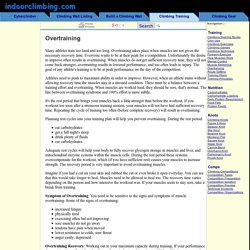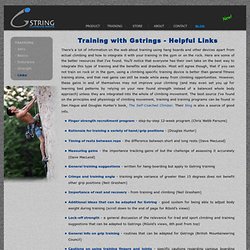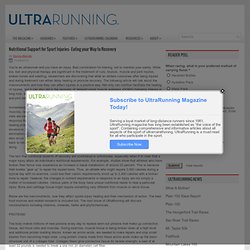

Overtraining. Many athletes train too hard and too long.

Overtraining takes place when muscles are not given the necessary recovery time. Everyone wants to be at their peak for a competition. Unfortunately the desire to improve often results in overtraining. When muscles do not get sufficient recovery time, they will not come back stronger--overtraining results in lowered performance, and too often leads to injury.
The goal of any athlete's training is to be at peak performance on the day of the competition. Athletes need to push to maximum ability in order to improve. It's the rest period that brings your muscles back a little stronger than before the workout. Planning rest cycles into your training plan will help you prevent overtraining. Eat carbohydrates get a full night's sleep drink plenty of fluids eat carbohydrates Adequate rest cycles will help your body to fully recover glycogen storage in muscles and liver, and mitochondrial enzyme systems within the muscle cells. Books about Overtraining: Common Climbing Injuries and Ways to Avoid Them - Dr. Jason Scoppa. At elemental health we see quite a few rock climbers, and they are usually atypical patients in that they have great core strength, are physically fit and active, and already do a good job in terms of diet.

Most climbers come in with, you guessed it, upper extremity problems. First I’m going to list some common rules of thumb when it comes to training and rehab for rock climbers. Next I’ll list the most common climbing related injuries we see, and what you can do to heal faster and prevent the problem from re occurring, or prevent it from occurring in the first place. Links. Training with Gstrings - Helpful Links There’s a lot of information on the web about training using hang boards and other devices apart from actual climbing and how to integrate it with your training in the gym or on the rock.

Here are some of the better resources that I’ve found. You’ll notice that everyone has their own take on the best way to integrate this type of training and the benefits and drawbacks. Most will agree though, that if you can not train on rock or in the gym, using a climbing specific training device is better than general fitness training alone, and that real gains can still be made while away from climbing opportunities.
How to Tell When You're Over-Reaching or Over-Training. 2.

This inability to increase the pulse goes hand-in-hand with a muscular heaviness or overloaded feeling. Quite often there is a simultaneous tightness and stiffness in the joints. Regardless of the length of your warm-up, the muscles remain lethargic and heavy. Indoor Rock Climbing. Links. Cheap Tricks. How long has it been since you noticed a real improvement in your climbing?

If it has been a year or two, then you are probably still reaping the benefits of your previous breakthrough. If it's been three or four years, then frustration may be creeping in. Half a decade or more and you may have given up all hope of reaching the next level. We all get stuck at various points in our climbing, and it's easy to haul out the same old excuses: insufficient training time and the same uncooperative body in the same gym. Nutritional Support for Sport Injuries – Eating your Way to Recovery. You’re an ultrarunner and you have an injury.

Bad combination for training, not to mention your sanity. While ice, rest and physical therapy are significant in the treatment of cuts, bruises, muscle and joint injuries, broken bones and swelling, researchers are discovering that what an athlete consumes after being injured and during treatment can either delay healing or promote recovery. The following article will talk about the macronutrients and how they can affect injuries in a positive way. Not only can nutrition facilitate the healing of injuries, but it can also aid in the recovery of delayed onset muscle soreness (DOMS) following intense or long runs. In addition, an anti-inflammatory diet is excellent for health in general, and post-workout muscle and joint recovery in particular. Immediately following an injury, the healing process begins.
Below are the macronutrients, how they affect sports-injury healing and their mechanism of action. Branched Chain Amino Acids (BCAA) Training Guide for rock climbing. Top 5 Pulling Exercises for Climbers « Nicros. Top 5 Pulling Exercises for Climbers Although your fingers and toes are your primary link to the rock, it’s the larger muscles of your arms, legs, and torso that facilitate most of the upward movement in climbing.

Of course, lack of leg strength is rarely, if ever, a limiting constraint on the rock—it’s the large pull muscles of the upper body that are most likely to fail you. Therefore, developing more upper-body strength, power, and endurance must be central to every training-for-climbing program. While simply climbing a few days per week will build a moderate level of pulling strength and endurance, use of more target training techniques will provide beneficial gains so that the pull-muscles will never limit you on the rock. Toward this end, let’s examine 5 exercises for improving strength and endurance in your pulling muscles. Exercise #1 is the Pull-up… Undoubtedly the most universal exercise used by climbers. Pulling exercise #2 is Weighted Pull-Ups (and pull downs).
Top 5 Finger Strength Training Exercises « Nicros. Top 5 Finger Strength Training Exercises I’m often asked to provide a list of the best exercises for training finger (grip) strength.

While there are dozens of different exercises (and variations thereof) that I could describe, in this article I present a generalized list of training techniques. Visit the Training Center archive to find more in-depth articles on some of these exercises. 1. BoulderingBouldering is certainly the most straightforward—and fun—way to train grip strength. Despite these limitations, bouldering should be a staple of your training program. First, select a boulder problem that appears to be strenuous, but not technically difficult. Training Guide for rock climbing. Strength Training for Climbing. Strength Training for Rock Climbing at Wellness.MA. Conditioning for Rock Climbing and Hiking Wayne L.

Westcott, Ph.D. A few years ago we conducted some research studies on the physiological benefits of rock climbing, using a mechanical rock climbing apparatus that allowed us to collect data on each exercise session. We actually trained 30 men and women for 20 minutes a day, two days a week, for a period of eight weeks on a Treadwall revolving rock climbing machine. Even this rather limited amount of simulated rock climbing produced significant improvements in body composition, muscle strength, joint flexibility and cardiovascular endurance.
Of course, there is another side to the rock climbing coin.